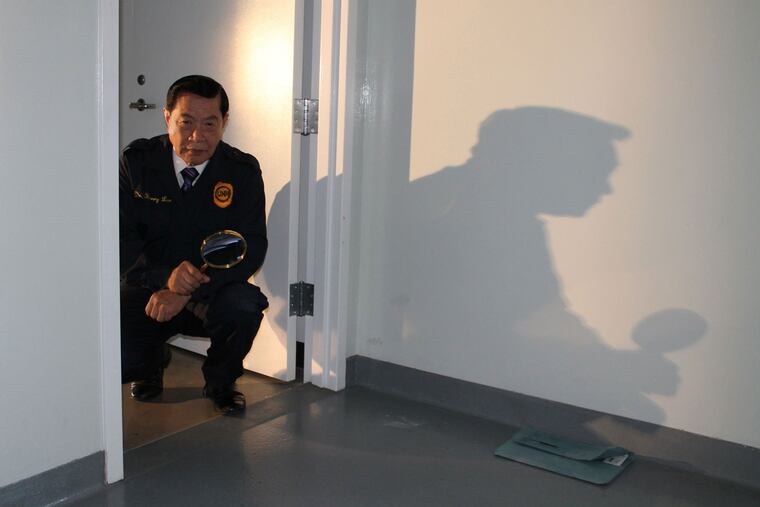'Sherlock' not as careful as its subject
Western society's most significant advances in crime detection didn't come from a police force or a pioneering scientist. They came from a fictional character, Sherlock Holmes.

Western society's most significant advances in crime detection didn't come from a police force or a pioneering scientist. They came from a fictional character, Sherlock Holmes.
That's the claim made by PBS's How Sherlock Changed the World, a two-hour documentary airing at 9 p.m. Tuesday, with narration by The Walking Dead's Andrew Lincoln in a smooth, seductive, for-real British accent.
A repetitive, highly selective scavenger hunt through Sir Arthur Conan Doyle's Holmes oeuvre that tends to be more exhausting than exhaustive, the show strategically leads the way for two returning Holmes dramas. One is CBS's Elementary on Jan. 2, starring Jonny Lee Miller as the consulting detective. The other is PBS's Sherlock on Jan. 19, a true contemporary masterpiece produced by the BBC and featuring Benedict Cumberbatch as Holmes and The Hobbit's Martin Freeman as his companion Dr. John Watson.
Dubbing him "the first CSI," How Sherlock Changed the World offers testimonials to his perspicacity from contemporary criminologists and historians, including the famous blood- and fingerprint-analysis expert Henry C. Lee, often called America's Sherlock Holmes. Interviews are interspersed with snippets from Sherlock and a series of sometimes cringe-worthy low-budget dramatizations featuring actor Edward Cartwright as Holmes.
While doing little to prove it, the docu claims that Conan Doyle's eccentric hero invented the very idea of crime detection through evidence-gathering and analysis in an era when police were deployed to prevent crimes, not solve them. When murder did occur, they depended on eyewitnesses or, as the docu says, rounded up known criminals and sweated them.
Even though Scotland Yard's detective force was formed in 1842 - 45 years before the first Holmes novel - officers weren't taught investigative techniques until decades later, said Jerry Ratcliffe, a former officer of London's Metropolitan Police who teaches criminology at Temple University.
Ratcliffe, in a phone interview, said authorities in London founded the detective unit in response to mounting pressure following a high-profile robbery. The paucity of knowledge about criminology was obvious from the way they went about it.
"The Met advertised in newspapers that they were hiring some 'intelligent men' who could help investigate the robbery," said Ratcliffe, who does not appear in the PBS film. "Police simply weren't trained to be investigators. . . . I don't think a training program was introduced until the 1920s."
How Sherlock Changed the World excels in its detailed analysis of the first Holmes mystery, A Study in Scarlet.
Appearing in 1887, a year before Jack the Ripper's reign of terror in London, the novel provides a wonderful précis of Holmes' methods. Police are perplexed when they find a dead man in an empty house. He has no wounds; there is no evidence of how he died. The word "RACHE" is scrawled in blood on a wall.
Holmes does something remarkable, said criminologist Karen Smith, who appears in the show and is a training consultant at the National Forensic Academy at the University of Tennessee. Holmes demands the scene be protected from contamination - virtually unheard of at the time. "Then," she said, "he gets on his hands and knees with a magnifying glass."
Holmes sniffs around the body, the face, the lips, and discovers the man was poisoned.
The magnifying glass, synonymous with Holmes, "is the key piece of equipment for a criminologist," Smith said.
Holmes has become the standard-bearer for the scientific method in policing, Ratcliffe said. Not so surprising, considering that his creator was a doctor and the protege of one of Britain's most brilliant medical minds, Joseph Bell.
Bell taught Conan Doyle to use inductive methods to trace symptoms back to their cause - the root illness - just as Holmes collates evidence to arrive at the whys and wherefores of a crime.
William L. Fleisher, a former FBI agent and Treasury Department investigator who also appears in the docu, said Conan Doyle's stories contain elementary investigative techniques such as crime scene protection, bloodstain and splatter analysis, ballistics and bullet trajectory, and shoe and handprint analysis.
Yet, he said by phone, one can't credit Holmes with inventing modern detection.
Conan Doyle lived and worked in an era of scientific innovation, said Fleisher, who was born in Wynnefield and worked out of Treasury's local offices. "Techniques were being developed around the time for fingerprinting and there were studies about blood pressure and breathing changes during deception."
Conan Doyle was well-read in some of these studies, he said, and most likely aware of the pioneering work of French criminologist Eugène François Vidocq. A reformed criminal and the model for Victor Hugo's most famous pair of characters, Jean Valjean and his nemesis Javert, Vidocq introduced in the mid-19th century many police methods that the PBS documentary credits to Holmes.
"Holmes wasn't the inventor of detective work," Fleisher said, "but he became the icon for it. . . . the first to universally capture the imagination of the public."
TV REVIEW
How Sherlock Changed the World
WHYY TV12, 9 p.m. TuesdayEndText